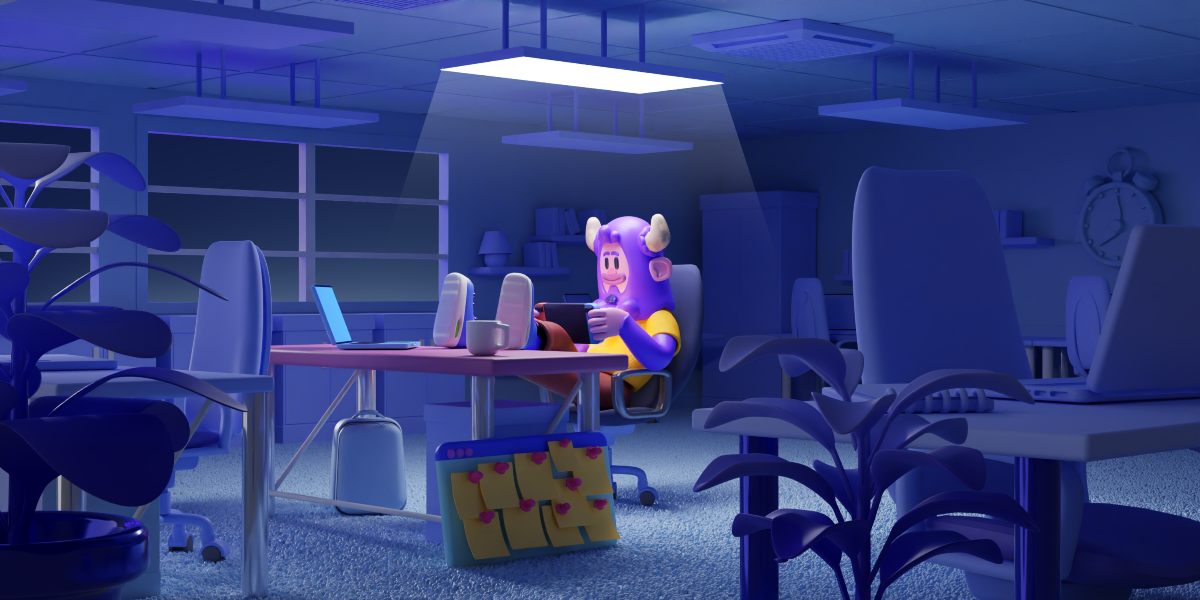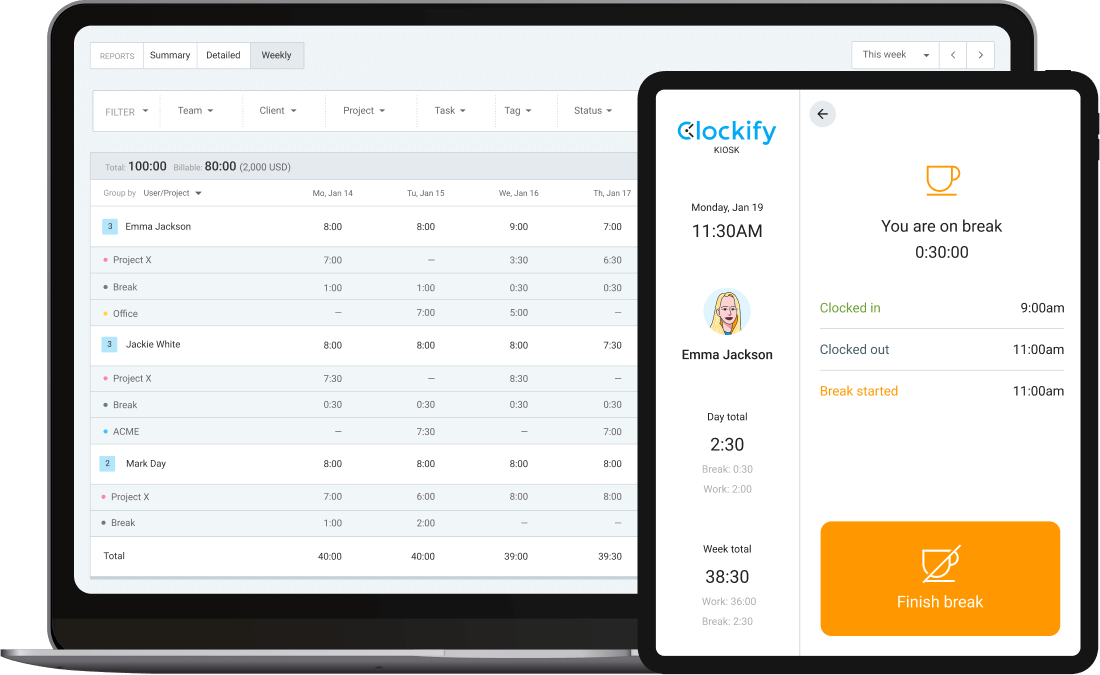Open-plan office, or open office, is a working environment where there are no internal walls and no divided, smaller offices. These working settings are popular among many companies worldwide because their main purpose is to inspire communication between employees.
Also, did you know that the concept of open office was first introduced back in the early 1900s?
Nowadays, more and more companies gravitate towards open office spaces as a means to combat lack of productivity and increase efficiency.
So, we decided to do some research on the open-office concept and answer some of the following questions:
- What is the open-office concept?
- What are the advantages and disadvantages of working in open-plan offices?
- How does the open-office concept affect productivity?

- Open-plan office is a working area where there are no internal walls and no segmented parts to the offices.
- There are three ways to design an open office: fully-open, half-open, and team-structured.
- The advantages of opting for the open office concept are numerous, some of which are health benefits, boost in creativity, and improved company culture.
- On the other hand, open-plan offices can be loud and noisy, as well as impact productivity in a negative way.
- To increase productivity in an open office, experts suggest creating a private area for yourself, communicating your needs to your colleagues, and scheduling important tasks when the office is quiet.
Table of Contents
What is the open-office concept?
Simply put, the open-office concept represents the idea of tearing down both physical and metaphorical walls in an office. Such an office includes one or several large spaces with no cubicles or divisions between working areas where employees are free to communicate and collaborate on tasks and projects, among other things.
However, based on the needs of the company and the type of work that is being done, open-plan offices can take different forms:
- Fully open offices,
- Half-open offices, and
- Team-structured offices.
Open-plan office type #1: Fully open offices
Fully open offices are just what the name suggests — large areas with no walls that compartmentalize workers, teams, and departments. Such offices are perfect for companies that deal in the creative field, for instance, but also for employees that are in need of constant collaboration in order to do their job.
The most common departments that make use of the open-office layout include:
- Software development,
- Sales,
- Project management,
- Media,
- Research,
- Consulting services, and others.
Open-plan office type #2: Half-open offices
In contrast, half-open offices provide a much needed balance for teams that require collaboration on a daily level — but do include privacy and individual work. Generally, such offices usually include partitions that divide the working area into open stations, but occasionally include an office or two for meetings and “focus” time.
Open-plan office type #3: Team-structured offices
Finally, open-plan offices can be divided into several open areas that are segmented for task-purpose teams. In other words, employees work in groups but their working stations are physically separated from other teams.
For example, an IT company can choose an area where developers work together, while HR conducts meetings in a separate room.
What are the advantages of an open-plan office?
From team collaboration to improved efficiency, open-plan office design has a number of advantages that are missing from the modern remote culture.
Some of the main reasons why most employers choose to go for open-plan offices are the following:
- Health benefits,
- Creativity benefits, and
- Promotion of company culture.
Open-plan office advantage #1: Health benefits
It might seem obvious, but there are health benefits from working in an open office that deserve a mention backed up by data and studies. Let’s dig in.
Being cooped up in small office spaces has a negative impact on both your physical and mental health, claims Jennifer Veitch, Ph.D in her research paper on workplace mental health.
High-density offices are associated with increased psychosocial work stressors and reduced environmental satisfaction, causing more cognitive issues, such as decreased working ability and troubles concentrating.
She claims that the surrounding environment of your workplace is crucial for preserving mental health. The light, open space, and interaction with colleagues reduce workload stress.
💡 Clockify Pro Tip
Whether it’s work-related or personal, emotions often get the best of us, at the worst of times. To ensure it doesn’t happen next time you’re at work, take a look at some of the tips from the following blog:
Another research published in BMJ Journals claims the following: “Open bench seating may be an unrecognized positive factor in promoting physical activity levels at work.”
The study had 231 participants wear a chest-worn heart and physical activity monitor, for three workdays in a row and two nights. The results of the study showed that open-office employees were 20% more physically active than employees in cubicles.
Compared to the workers in a private office, open-bench seating employees proved to be 32% more active. In addition, workers with higher levels of physical activity also had lower levels of physiological stress outside the office.
Open-plan office advantage #2: Creativity boost
Open floor plans can be an ideal solution for teams in need to communicate and exchange their ideas.
For example, if you’re having frequent brainstorming sessions, be sure that this setting is perfect for you and your team. Since there are no walls or any visual boundaries, creativity can thrive in open workspaces.
Some industries than can truly benefit from an open-floor plan are:
- Graphic design,
- Content marketing and social media,
- News industries,
- Software development, and
- Contact centers.
💡 Clockify Pro Tip
If your team is struggling to come up with new ideas, the following tips on brainstorming will serve as a true eye-opener.
Open-plan office advantage #3: Company culture and communication
By selecting an open space layout, companies send a clear message to their employees and the market — all our employees are equal and have equal rights. Besides, this layout changes the perspective of a hierarchy within the company, and for better.
So, when senior leaders are in the same space as other workers, employees will feel more open to collaborate with the company’s leadership.
Finally, team members will be more likely to get to know each other when working in an open workspace.
In fact, a study on workplace engagement and communication by Humanyze — an organizational analytics software firm — proved that colleagues from the same team were six times more likely to communicate when they were on the same floor.
This research demonstrated that workers from different teams were nine times more likely to engage in conversations when they were on the same floor.
Every type of office layout has its pros and cons. In order to see the bigger picture, we’ll explain the major downsides of working in an open office in the following section.
What are the disadvantages of an open-plan office?
There are many drawbacks to working in an office, especially the ones with an open concept.
Some of the most notable drawbacks that we were able to pinpoint are the following:
- Loud and noisy environment,
- Lack of face-to-face interactions, and
- Decreased productivity.
Now, let’s find out more about each of them.
💡 Clockify Pro Tip
Also, if you’ve recently started working from home or remotely, here is an amazing article that will help you stay motivated, organized, and productive:
Open-plan office disadvantage #1: Loud and noisy environment
Deep focus and deep work are concepts that most of us are familiar with, but we often tend to disregard just how important they are.
According to Cal Newport, deep work is described as: “Activities performed in a state of distraction-free concentration that push your cognitive capabilities to their limit.”
However, research from Edward Brown, co-founder of the Cohen Brown Management Group, found that delving into deep work is nearly impossible in an open-office space.
According to the results, 93% of workers said they feel interrupted at work, the culprit being noise, interactions, and the general atmosphere of the working area.
Moreover, the author of the book How to be Heard and Sound Business, Julian Treasure believes that noise is the number one issue in open workspaces.

“It (noise) dramatically reduces productivity in solo working — we all know how tough it is to concentrate when we can hear unwanted conversations around us. Recent research is now revealing that it even reduces collaboration, because people prefer not to be overheard so they choose to email rather than speak.”
Open-plan office disadvantage #2: Lack of face-to-face interactions
A research on The impact of the ‘open’ workspace on human collaboration analyzed the corporate headquarters before and after transitioning to open-plan offices.
During these studies, 52 participants in the first and 100 in the second survey, were wearing a sensor that recorded face-to-face interactions. Also, the researchers gathered email data, to examine electronic interactions between the employees.
The results of these studies showed that the volume of face-to-face interactions went down for approximately 70%. On the other hand, there was a growth in the number of electronic interactions — from 20% to 50%.
So, why do people avoid face-to-face communication in open-plan spaces?
The researchers believe that’s because workers don’t like speaking loudly in this layout. The reason is simple — they don’t want to distract their colleagues.
Open-plan office disadvantage #3: Decreased productivity
A study conducted by researchers from Karlstad University on working in open-plan spaces revealed that once cooped up in a single open space, employees tend to feel more suffocated and less satisfied, which further leads to decreased productivity.
What’s more, when it comes to transparency in an open-floor plan, findings show that 31% of employees don’t feel comfortable expressing their opinions when having calls in the office. That’s because the participants don’t want their colleagues to hear and judge them.
—
These are the most common drawbacks of working in an open office. But, the fact that there are some negative sides doesn’t mean that finishing your tasks in this kind of environment is impossible.
💡 Clockify Pro Tip
Remote and office workers tend to suffer from the same syndrome — sometimes you just cannot focus at work. If you’re looking for ways to stay motivated while working, the following tips will be perfect for you:
How to be productive in an open-plan office?
Research and studies are one thing, but experience has a different type of value that adds to the integrity of the topic at hand.
Therefore, we reached out to several productivity professionals, as well as a sound and communication expert, to learn how to cope with working in open-floor plans.
Open-plan office productivity tip #1: Focus on creating more private areas
To Alexis Haselberger, a time-management and efficiency expert, open offices are a bit of a scourge on modern society. In her opinion, these settings are so full of distraction that it’s hard for most people to get work done productively in them.
However, to make this layout more effective for everyone, she has some amazing suggestions for employers, especially when it comes to making your space comfortable and calm to work in:

“Create lots of ‘private’ nooks using furniture spacing (think: comfy chair in a corner). Provide noise-canceling headphones so that employees are less distracted by the conversations of others.”
Then, she recommends employers to designate “quiet areas:”

“Just like the quiet car of a train, designate quiet areas of the office. Install ‘phone booths’ with sound protection so that people on calls aren’t bothering everyone else.”
Finally, she emphasizes the importance of having enough conference rooms so that meetings don’t need to be held in the office. Besides, she promotes another practical option — working from home, as a way to increase employee productivity.

“Let people work from home when they need to, head’s down time.”
Open-plan office productivity tip #2: Think about the acoustics of your office
A 5x TED speaker and the founder of The Sound Agency, Julian Treasure, explained in a TED talk video that sound affects our well-being and productivity.
Julian invented a simple rule for dealing with noise in loud working environment — MBA, which stands for:
M — Move and find a quiet place where you can concentrate,
B — Block, which involves using headphones (preferably noise isolating headphones), and
A — Accept working in a noisy environment.
Speaking of employers and how they can create a better working setting, a more productive one, Julian told us the secret of a perfect office lies in sound design:

“The answer is to design with the ears as well as the eyes, creating spaces that sound right for the different kinds of work we do and enhancing privacy in open-plan spaces.
The best way of doing this is with biophilic soundscapes, which bring the health-giving, refreshing sounds of nature into the workspace.”
If you’d like to learn more about how soundscapes can make us more productive, check out The Secret of How Sound Can Make You Be Happier & Achieve More with Julian Treasure podcast.
Open-plan office productivity tip #3: Let your colleagues know what you need in order to be effective
Julia Arndt is a stress management trainer and a founder of the Peak Performance Method. She claims that making your workstation more personal has an immense value for your productivity levels.

“Create a safe space — bring plants, pictures of your loved ones, maybe another lamp to make you feel comfortable in your own space.”
Moreover, Julia points out how communication has intrinsic value for both employers and employees.
Communicating what you need is one of Julia’s tricks for working in an open-office layout:

“Set clear boundaries by communicating what you need — some people might just wear headphones to be “left alone” from in-between chats and others might look to book a conference room to work quietly. Also, have an open conversation during a team meeting on what everyone needs to be more productive.”
Open-plan office productivity tip #4: Schedule important tasks when it’s quiet in the office
Kirstin O’Donovan is a productivity coach and a founder of TOPResults Coaching. She claims that distractions and interruptions in open-space layout are a huge productivity killer.
For better organization in open offices, Kirstin recommends planning out your tasks in advance and compromising with the needs of the office:

“People interrupt continuously in an open-space office, so try to plan your tasks accordingly. If you know that between 9:00 – 10:00 a.m. it gets really loud because everyone is having a coffee break, don’t plan the tasks that require the most focus for those times. Plan your time, matching the energy of the office and the task where possible.”
Additionally, Kirstin recommends making visual barriers to your workspace as a way of combating interruptions:

“Protect your space by creating some division where possible, even visually, to prevent your eye from catching so much movement, use a Do not Disturb sign to prevent interruptions.”
Open-plan versus closed office: Which one should you choose?
First off, it’s important to note that there is no right answer to this question. Both choices entail certain benefits and cons that could be the decision-makers in designing your current or future office.
However, 3 main factors can be crucial in helping you make the right decision for your business:
- Organizational culture,
- Business’ needs, and
- Employee preferences.
Factor to take into consideration #1: Organizational culture
Simply put, organizational culture is generally referred to as a set of company’s beliefs and standards, and the way they reflect on its employees.
For example, if a company presents itself as eco-friendly, you’ll rarely see any furniture made of wood or wooden tiles in the office.
In the same vein, most employees that share the same belief will participate in the movement by recycling or collecting contributions for eco causes. Now, when it comes to organizing the office, some companies value grind culture and individual work, which is where a closed, cubicle office presents itself as a solution.
On the other hand, if a company thrives under the slogan “all for one, and one for all”, an open-office concept is the way to go.
💡 Clockify Pro Tip
Is your team struggling to communicate and work together? Do you think your team members can improve their relationships? If these questions trouble you, take a look at the following blog for more information:
Factor to take into consideration #2: Business’ needs
Some businesses simply cannot function when team members don’t work together. The modern era has brought upon us numerous ways to stay connected, yet sometimes, live interaction cannot be replaced.
Most modern offices require teams to attend:
- Meetings,
- Seminars, and
- Workshops.
Therefore, take into account the number of workers your business employs and what type of office would benefit them the most in order to conduct various meetings.
For example, a business that employs more than 200 employees cannot thrive in an open-office environment due to all the noise and distractions.
Also, the type of work you conduct is important when choosing between close and open offices.
Some IT businesses might thrive in a closed office with cubicles since the privacy allows developers to focus on the task at hand. On the other hand, digital marketing agencies certainly have more benefits in working in an open environment where communication is key.
Factor to take into consideration #3: Employee preferences
Finally, it’s important to note employee preference as a factor since, at the end of the day, they’ll be the ones working there. Some people are just naturally more inclined to working alone, opposed to extraverted individuals that thrive in crowded environments.
The best way you can deal with this factor is to have HR conduct meetings and ask for everyone’s opinion on the office and how it relates to their work productivity.
Consider Clockify for tracking attendance and productivity in your office
Whether you or your employees work in an open or closed office, make sure you keep track of work hours. Clockify is a time tracking app that helps you track your or your employees’ tasks, projects, and your employees’ clock-in and clock-out time entries.
By using Clockify’s Kiosk feature, any device can be transformed into a clock-in device that the entire office can use. Alternatively, Kiosk can be used remotely by filling in timesheets via apps for mobile, desktop, and web.
So, how does it work?

After you sign up for Clockify and invite your team to a joint workplace, you’ll have to create your Kiosk. Name it, assign people to it, and set up a PIN sign-in system that you’ll share with your employees.

Then, your employees will be able to login and start their work shift by pressing the Clock In button. Also, you can dedicate a certain amount of time to the Start Break function and have employees enjoy their meals without worrying about how much time has passed.
When your employees clock-out, you can review the activity, track and analyze their progress and find holes in the system that need to be fixed.


